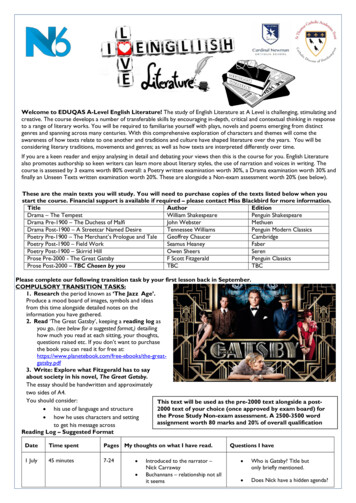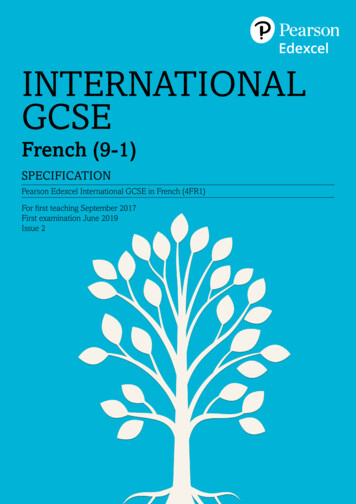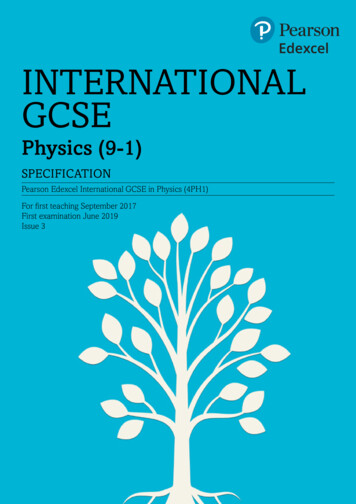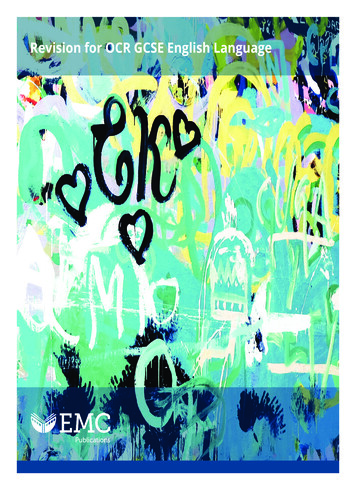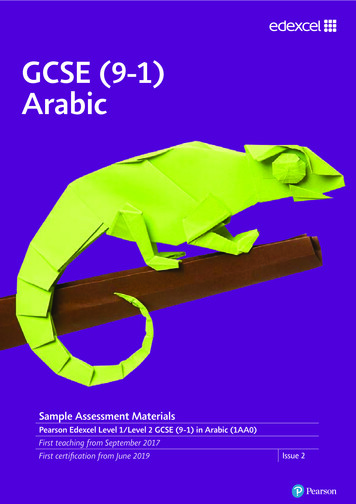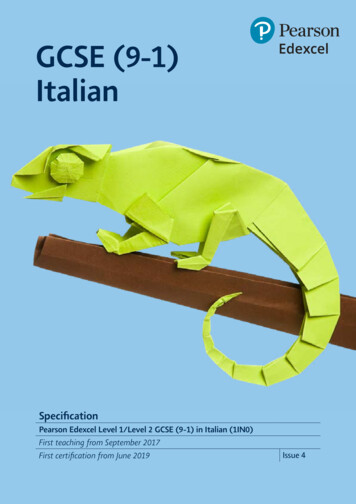
Transcription
CSCP Support MaterialsforEduqas GCSE LatinComponent 2Latin Literature and Sources (Themes)Superstition and MagicFor examination in 2021-2023 University of Cambridge School Classics Project, 2019
PUBLISHED BY THE CAMBRIDGE SCHOOL CLASSICS PROJECTFaculty of Education, University of Cambridge,184 Hills Road, Cambridge, CB2 8PQ, UKhttp://www.CambridgeSCP.com University of Cambridge School Classics Project, 2019CopyrightIn the case of this publication, the CSCP is waiving normal copyrightprovisions in that copies of this material may be made free of charge andwithout specific permission so long as they are for educational or personaluse within the school or institution which downloads the publication. Allother forms of copying (for example, for inclusion in another publication)are subject to specific permission from the Project.First published 2019version date: 20/12/2019This document refers to the official examination images and texts for the Eduqas LatinGCSE (2021 - 2023). It should be used in conjunction with the information, s Latin GCSE (2021-2023)Information about several of the pictures in this booklet, together with useful additionalmaterial for the Theme, may be found in the support available online forCambridge Latin Course, Book I, Stage 7 and Book III, Stages 22-23. University of Cambridge School Classics Project, 2019
Theme B: Superstition and MagicCandidates are expected to be familiar with the following aspects of the theme: the work of an augur, the work of a hauspex; defixiones (curse-tablets).Candidates should study the pictures in the Eduqas Prescribed Material Booklet, oneor more of which will be used as a basis for questions in each question paper.Candidates will also answer questions on the texts in the Eduqas Prescribed MaterialBooklet.ContentsIntroduction . 2Picture 1: road surrounded by tombs . 8Picture 2: a defixio . 9Picture 3: preparations for a sacrifice . 10Picture 4: bronze model of a liver . 11Picture 5: Romulus’ and Remus’ augury . 12Picture 6: Augustus (centre) as an augur . 13HORACE Omens good and bad (Odes 3.27. 1-16) . 14MARTIAL Cures for bad dreams (Epigrams 7.54) . 20OVID Dipsas the sorceress (Amores 1.8.1-18) . 24PETRONIUS A spooky story (Satyricon 61-62) . 31PLINY An alarming dream comes true (Letters 5.5) . 39SUETONIUS, The portents before the murder of Julius Caesar (Divus Iulius 81) 43VIRGIL Dido prepares a curse (Aeneid 4.504-521) . 49 University of Cambridge School Classics Project, 20191
IntroductionThe Roman world was filled with gods and their landscape was filled with ritual. A poolmight be the home of a nymph, a tree the home of a dryad; the threshold of everybuilding held significance and every crossroad might be a meeting place of spirits.Theirs was a world in which you interacted with the divine and the supernatural on aregular basis.State religious practices and worship of the main gods was organised by prescribedritual and conducted by colleges of priests. These religious practices were often heldin public, but for the most part the people played a fairly passive role, unable to entermost temples or to take a direct part in the ceremonies. There werealso regular festivals and rituals throughout the year, observed by the population as awhole and which marked out the Roman calendar.In addition to public and collective interactions with the divine, an individual mightchoose to be initiated into a cult such as those of Isis or Mithras, often undergoingtraining or a series of tests before reaching the status of initiate. These cults enabledworshippers to establish a more personal connection with a specific power andperhaps to hope for a reward in return for their devotion. These cults were toleratedin Roman society provided that they did not interfere with an individual’s participationin the rites of the established Roman religion.Any individual might experience direct contact with the divine or supernatural in otherways. Dreams were held in great esteem as tools of divination, whether you believedthey were messages and instructions direct from the gods or symbols to enable youto make sense of your life. Dream manuals survive from the Roman world which showus that people regularly consulted on the meanings of their dreams. In fact theRomans made use of a wide range of divination techniques. For Platonists and Stoics,everything in the world was imbued with the cosmic soul and therefore could be usedto tell the future. Acts of divination were as varied as casting sand into the wind andobserving the patterns it made as it fell, or observing the patterns of flames in a fire.This selection of sources looks at some of the different ways in which the Romansexperienced contact with the world of superstition and magic: through forms ofdivination; through their perceptions of supernatural creatures; and through theirattempts to control this world with spells and curses. University of Cambridge School Classics Project, 20192
Exploration of the themeIn this theme, the following topics will be covered: communication with the world of the divineo sacrificeso appeasing the dead divinationo the work of an auguro the work of a haruspexo dreamso omens curseso defixioneso spells warding off evilo sacrifices the supernaturalo depiction of witches and witchcrafto werewolveso spiritso some magical places and artefactsStudents will undoubtedly have their own knowledge which they can bring to this topic.Explorations which compare ancient and modern attitudes towards magic andsuperstition are to be encouraged.Ways to start might include establishing what superstitions they know from their ownexperience, e.g. black cats crossing your path, saying ‘bless you’ after sneezes,avoiding walking under ladders, breaking a mirror etc. They may also know ways of‘telling the future’ (tarot, for example).Modern depictions of werewolves are very similar to ancient ones, and so studentsmay well have a clear idea of how they look and act. Comparisons of ancientdepictions of witches with later European witch trials is illuminating in terms of similarprejudices against women.It may be useful to tackle the source material thematically. The texts are presented inthe booklet in alphabetical order according to author in order that the teacher is freeto use their professional judgement in presenting the material to their students inwhatever order seems best. University of Cambridge School Classics Project, 20193
SourcesSourceTypeWriter and ContextSubject and ThemesImagesPicture 1: Roadsurrounded by tombsVia dei Sepolcri,Pompeii appeasing the spiritsof the dead magical artefacts andlocationsPicture 2: A defixio(curse tablet)lead tablet communicating withthe divine magical artefactsPicture 3:Preparations for asacrificealtar the role of a priest how a sacrifice iscarried outPicture 4: Bronzemodel of a liverbronze model the role of theharuspex divination throughharuspicyPicture 5: Romulusand Remus’ auguryprint divination throughauguryPicture 6: Augustus(centre) as an auguraltar divination throughaugury the objects and dressof an augurTextHoraceOdes 3.27.1-16poetryexcerpt writer of poetry in avariety of styles the poet wishesgood omens upona friend departingthe city on a longvoyage the poet gives a list ofbad omensMartialEpigrams 7.54poetrywhole work writer of shortpoems (epigrams)on various subjects the poet addressesNasidienus the poet takes baddreams very seriously evidence for how toward off bad omens University of Cambridge School Classics Project, 20194
OvidAmores 1.8.1-18poetryexcerpt writer of lovepoetry the poet is writingas though he ishiding on thethreshold of hisgirlfriend’s home describing the oldwoman he seestalking to hisgirlfriend the poet describes aRoman witch andwhat powers she wassupposed to have hadPetroniusSatyricon 61-62proseexcerpt writer and memberof the imperialcourt an excerpt from anovel a first personaccount told at adinner party the author describesan encounter with awerewolfPlinyLetters 5.5letterexcerpt lawyer, politicianand writer letter to his friend writing about thedeath of the writerGaius Fannius a dream is describedand interpretedSuetoniusDivus Iulius 81proseexcerpt writer of biography writing about thedeath of JuliusCaesar a haruspex warnsCaesar of hisimpendingassassination an unfavourablesacrifice is performed there are further badomensVirgilAeneid 4.504-521poetryexcerpt writer of epicpoetry the queen ofCarthage preparesa curse for Aeneas the setting is thelegendary past a description of theritual surrounding acurse magical artefacts aredescribed the appearance of apractitioner of magicAs is usual with Latin literature, we should bear in mind that the authors we are hearingfrom are male and upper-class. University of Cambridge School Classics Project, 20195
Suggestions for reading and teachingKey aims are: Understanding the meaning of the Latin Literary appreciation Developing an understanding of the topicIt is often useful to adopt the following approach when introducing students to originalliterature: Read the Latin aloud to emphasise phrasing and stress word groups Break up more complex sentences into constituent parts for comprehension Focus on comprehension of the text and understanding the content throughquestioning and using the vocabulary Look closely at how the Latin is expressed and the ways in which the literary devicesenhance the meaning. Although a sample translation is provided in the course resources, teachers mightwant to encourage their students to make their own version after various optionshave been discussed and evaluated. The first step is a literal translation, thensomething more polished in natural English that is as close to the structure andvocabulary of the original Latin as possible. Students will soon see that a degree ofparaphrasing may be required when the Latin does not readily translate into correctand idiomatic English.About the Teacher's NotesThe following Notes focus on language, content, style and literary effect. TheDiscussion and Questions focus mostly on literary appreciation and interpretation.Rhetorical and technical terms are used throughout the notes. Some of these may beunfamiliar to teachers new to teaching Latin literature; a definition will be supplied. Asthe teacher is free to teach these sources in any order they wish, there will beduplication within the notes from time to time.The notes are designed to provide for the needs of a wide spectrum of teachers, fromthose with limited knowledge of Latin and who are perhaps entirely new to readingLatin literature, to teachers experienced in both language and literature. It is hopedthat all will find something of use and interest. Teachers should not feel that theyneed to pass on to their students all the information from these notes; theyshould choose whatever they think is appropriate.Some of the information contained in the notes is for general interest and to satisfy thecuriosity of students and teachers. The examination requires knowledge outsidethe text only when it is needed in order to understand the text. University of Cambridge School Classics Project, 20196
The Teacher’s Notes contain the follow: An Introduction to the author and the text, although students will only be askedquestions on the content of the source itself. Notes on the text to assist the teacher. Discussion suggestions for students and overarching Themes which appearacross more than one source. Suggested Questions for Comprehension, Content, Style and Culture tobe used with students. Further Information and Reading for teachers who wish to explore the topicand texts further. None of this is intended for examination.Further reading on Magic and SuperstitionCambridge Latin Course Book I, Stage 7, pages 93-95 (Roman beliefs about life afterdeath)Cambridge Latin Course Book 3, Stage 22, pages 34-35 (Magic and curses)Cambridge Latin Course Book 3, Stage 23, pages 48-53 (Roman religion, includingdivination)B. Ankarloo and S Clark, Witchcraft and Magic in Europe, Vol. 2: Ancient Greece andRome (University of Pennsylvania Press, 1999)Mary Beard, John North and Simon Price, Religions of Rome Vol. 1: A History(Cambridge University Press, 1998)Mary Beard, John North and Simon Price, Religions of Rome Vol. 2: A Sourcebook(Cambridge University Press, 1998)G. Luck, Arcana Mundi: Magic and the Occult in the Greek and Roman Worlds (JohnHopkins University Press, 2006)D. Ogden, Night’s Black Agents: Witches, Wizards and the Dead in the Ancient World(Bloomsbury, 2008) University of Cambridge School Classics Project, 20197
Picture 1: road surrounded by tombsThis picture shows the tombs lining the road out of Pompeii towards Herculaneum.These marble tombs were in a prestigious location, as this was also the main routeto and from Rome itself, and they commemorate important citizens and familieswho played an active role in the life of the town.Key information for studentsRoman burials took place outside towns as the dead were seen as having a miasmaor contagion which could pollute the living. The Romans were concerned about beingforgotten after death, however, and so the dead also required contact with the livingand regular visits to keep them happy. Roman tombs often have dining rooms orgathering areas attached which would have been used on special occasions.If the dead became unhappy, they could cause trouble for the living. Tombs were alsoseen as a place where the living could make contact with spirits and could use themfor magical purposes.Aside from the magical atmosphere of the necropolis, these areas often presented thetraveller with real dangers as they provided cover and housing for bandits and robbers.Additional notes for teachersThe Romans had specific rites andrituals to keep spirits happy, and to dealwith angry spirits if needed. TheParentalia was a nine-day festival inFebruary to honour the dead ancestors.It concluded with the public festivalFeralia and offerings of food, wine andflowers.The restless dead, however, especiallythose without family to performceremonies for them, would not beappeased by these actions and wouldneed to be dealt with during theLemuria festival in May when evil spiritswere driven out. Ovid describes theceremony in the Fasti, saying that thehead of the household must get up atmidnight and walk around the housewith bare feet, casting black beans overhis shoulder and chanting “These Isend; with these beans I redeem meand mine”. He would do this nine times,and then the whole house would loudlybeat bronze whilst commanding thespirits to be gone.The tombs of the untimely dead (victimsof suicide, child deaths etc.) were seenas a suitable place to deposit cursetablets: the spirit, bitter at its own fate,might be more likely to come to youraid. The miasma could also beharnessed by removing objects fromthe tombs to be used in spells: this oftenmeant that tombs were raided for theirbones. Disturbing a tomb waspunishable by death. University of Cambridge School Classics Project, 20198
Picture 2: a defixioThis picture shows one of the curse tablets found at Bath (Aquae Sulis) in thereservoir under the King’s Bath. It is 6.8 cm square, made of lead, with aninscribed text which has been written in Latin with each word reversed.It says “May he who has stolen Vilbia from me dissolve like water. May she whohas devoured her be struck dumb, whether it be Velvinna or Exsupereus orVerianus or Severinus, Augustalis, Comitianus, Catus, Minianus, Germanilla orJovina.”Key information for studentsDefixiones, were written on lead then folded or rolled, often pierced, then deposited ina magical location. The victim needed to be clearly identified, a divine power invokedand magical words used. The words might be arranged into a magical shape, andmystical pictures might also be included.Additional notes for teachersIt is not clear exactly what the Romansthemselves called these tablets. Theyappear all across the empire, and wereused by pre-Roman societies as well.Most defixiones are lovers’ curses,although many relate to trade andsporting competitions. Unusually, mostof the tablets found at Bath are appealsfor justice, mainly relating to stolenproperty.Defixiones seem to be particularly away to achieve restitution for poorerindividuals who were unable to afford orexpect justice through the law courts.There are some features common tomost defixiones. They were usuallywritten on lead (the Romans believedthat some materials had sympatheticproperties – the cold hard materialswould invoke the cold finality of deathand the coldness of the spirits beingcalled upon – and they are folded orrolled, often pierced with a nail (this isto ‘bind’ and ‘fix’ the magic, not to keepthe contents secret). They were thendeposited in a magical location. Thiswas frequently a grave or chthonicsanctuary in order to invoke the spiritstherein, or in a body of water.The language used to write a defixio isalso specific: a victim and a divinepower should be identified. Then thetablet is made more magical by the usea range of devices: using vocesmagicae, magical words which have noobvious meaning; mixing up thealphabet being used – e.g. Greek andLatin letters; arranging the words intoshapes, especially triangles andwinged shapes; writing upside down, orin spirals or as a 'boustrophedon' text(i.e. with lines read in alternatedirections); including mystical picturessuch as demons, bound figures andmummies. As can be seen from theseexamples, ‘twistiness’ was seen asinherently magical. University of Cambridge School Classics Project, 20199
Picture 3: preparations for a sacrificeThis relief from an altar is housed in the museum in the Royal Palace in Stockholm.Key information for studentsThis is a typical scene of sacrifice. The flaming altar stands in front of the temple. Thevictimarius with his sacrificial axe leads the willing victim, decorated lavishly, to beslaughtered. The priest, head covered, stands at the altar, ready to conduct the ritual.Beside him, a figure holds a tray ready to conduct offerings, such as the mola salsa –sanctified grain which would be sprinkled on the animal's back as a sign of dedicationto the gods.Additional notes for teachersThe Roman sacrifice had six phases,each of which had to be carried outsmoothly for it to be deemed a success.The victim, usually a domesticatedanimal such as an ox or pig, is led in aparade (pompa) towards the altar. Thisvictim must be blemish-free andgarlanded, and should behave calmlythroughout, giving the impression that itis in some way ‘willing’. Next offeringsand prayers are made at the altar. Thismight take the form of a libation(pouring out of wine) and the burning ofincense. The prayers must becompleted without any stumbling overthe words, otherwise it would have to bestarted afresh. Once this wascompleted, the victim was dedicated tothe gods. This was done through a ritualwhich symbolically took it out of ourworld and placed it into the world of thegods. Wine and mola salsa (sacredgrain) were poured over the animal, andthe knife passed over its back.The killing was carried out by a team ofpeople, although only the victimarius isdepicted here. The victim would bestunned (some sources show a malletbeing used) then the throat of theanimal was cut and it was bled to death.If the animal struggled then it was a badportent.Once the victim was dead, the entrailswould be inspected by a haruspex forany signs of blemishes or abnormalitieswhich would indicate that the offeringwas ill-omened. If this was the case,then they would start again with a freshanimal. If all was well, the entrails wereburned as an offering to the gods andthen the remainder of the animalcooked and portioned out to thegathered crowd. This would not happenin all sacrifices; animals weresometimes offered in their entirety tothe gods (a holocaust). University of Cambridge School Classics Project, 201910
Picture 4: bronze model of a liverThis is a life-sized bronze model of a sheep’s liver, found in Piacenza in Italy (ancientEtruria) and dating from the 2nd century BC. The inscriptions are Etruscan, althoughthe people would have been speaking Latin by this time.Bronze is associated with magic; iron was, in contrast, for warding off magic.Key information for studentsThis model would have been used by a haruspex as they read in the entrails of asacrificial victim in order to tell the future. They would be checking for blemishes orabnormalities which would indicate misfortune or an unfavourable sacrifice.Additional notes for teachersThe haruspices were a college ofpriests who interpreted unusual eventsand prodigies, including lightning andmonstrous births as well as the readingof entrails.The origins of thispriesthood seem to be Etruscan (preRoman Italian tribe), and the practiceshares elements with Hittite andBabylonian practices. Similar models tothis one have been found fromMesopotamia (one particularly goodexample is in the British Museum). It ispossible that the Romans even fosteredthe idea that the haruspex was in someway foreign in order to demarcate theserites from other priesthoods whichcarried out divination.After an animal had been sacrificed, theinnards would be read by the haruspex.This model liver is probably a guide tointerpreting the organ. It is marked outto show a map of the heavens, eachsection inscribed with the name of agod. This indicates to the haruspex therelationship between the liver and theworld of the divine. If there was ablemish, the sacrifice would be carriedout again unless it was impossible to doso.By the 1st century BC, there seems tohavebeensomescepticismsurrounding this form of divination,even though augury and dreams werestill followed. Cicero is frequentlysarcastic about haruspices, and quotesCato the Elder as saying “How can twoharuspices, upon meeting, not laugh ateach other?” University of Cambridge School Classics Project, 201911
Picture 5: Romulus’ and Remus’ auguryThis picture is a print by Giovanni Battista Fontana dating from around 1573. Itshows the legendary brothers Romulus and Remus using augury to resolve theirdispute over who should be the ruler of their new city.Key information for studentsRomulus and Remus had decided to found a city but, being twins, could not reach adecision who would rule. It was agreed therefore that the gods should decide and thataugury (the reading of bird signs) would be the method of determining their will.Romulus climbed to the top of the Palatine Hill to make his observations, and Remusclimbed to the top of the Aventine.Remus was the first to receive a sign, seeing six vultures. But whilst they werereporting this sign, Romulus saw twelve vultures. Each declared himself the winner,Remus because he had received a sign first and Romulus because he had seen thegreater number.At this point, according to Livy, the competition dissolved into taunts and violence.Eventually Remus was killed and thus the city became Romulus’ and Rome was itsname. The famous version of the story is that Romulus himself slew his brother afterRemus had jumped over the new walls whilst mocking him and his nascent city.Additional notes for teachersFor more on augury in general, see thenotes on picture 6. University of Cambridge School Classics Project, 201912
Picture 6: Augustus (centre) as an augurThis picture shows the Vicus Sandaliarius altar from Rome, now on display in the Uffizigallery in Florence.It was dedicated in 2 BC and was dedicated to the lares Augusti –the imperial cult.Augustus himself is in the middle, flanked by a member of his family to the left(probably Gaius Caesar) and a female figure on the right (perhaps Livia but more likelya priestess of the Magna Mater). Unusually, the lares themselves are on one side ofthe altar rather than on the front.Key information for studentsThe augur is in the middle, head covered, holding an augural staff (lituus). This wasused by an augur to mark out the sky into sections in order to observe the behaviourof birds. The left-hand side was generally considered unlucky. At his feet is a chickenpecking at the ground. This indicates another aspect of augury: the observation ofbirds eating.Additional notes for teachersThe emperor Augustus is depicted withhis head covered (he has pulled histoga over his head at the back, capitevelato). This was traditional whenacting in a religious role. In his left handhe holds a scroll: a volume of religiousinstruction. In his right hand he holds acurved augural staff, the lituus. Theobservation of chickens pecking waspart of the tripudium, the militaryauspices taken before a campaign. In 2BC Gaius led a military campaign toAsia Minor, Parthia and Armenia.Augures were mainly concerned withthe observation of bird signs, but theyalso read signs in thunder and lightning,and the behaviour of animals. Theceremony and observation itself wouldbe carried out by the magistrates whowished to know the will of the gods, theaugur advising and confirming thateverythingcorrectly.hadbeencarriedoutThe augur used his lituus to mark out areligious space called a templum. Anyplace designated a templum was awindow of communication with thedivine. A building could be a templum,but so could any space.Interestingly, Roman augures tended toface south when they marked out divinesections, and so the east –the luckydirection- was on his left (laevus left /lucky). Greeks, however, faced northand so for them left was unlucky(sinister). Roman authors, especiallythe Augustan poets, confuse the wholematter by describing things as if theythemselves were actually Greeks, sothe left-hand side is unlucky in the textswe have here! University of Cambridge School Classics Project, 201913
HORACE Omens good and bad(Odes 3.27. 1-16)The poet light-heartedly describes the bad omens which may befall a traveller.Quintus Horatius Flaccus (65BC-27BC) was a lyric poet writing under the emperorAugustus. Horace was born in southern Italy, at that time an area still closelyassociated with the Greek world, and he grew up steeped in Hellenistic culture.Although as a young man he lived in Rome, he soon moved to Athens where hecontinued his education. The turbulence of the era impacted upon him greatly:following the assassination of Julius Caesar he was recruited by Brutus to fight againstAntony and Octavian (the later Augustus). Horace later accepted a pardon fromOctavian and returned to Italy, but his family estates had been confiscated. He wasable to to turn his hand to writing and real success followed when he received thepatronage of Maecenas, one of Augustus’ closest advisers.This selection is taken from the beginning of Ode 3.27. The full poem is 76 lines intotal and our part focuses on a journey being undertaken by Galatea, a one-time loveof Horace. She is making her way south from Rome, along the Appian Way, pastLanuvium, and towards Brundisium where she will sail for Greece. It seems thatHorace is teasing her gently for her superstitions whilst writing a poem which is alsoan affectionate farewell (a propempticon). She should not worry about bad omens,they are for the wicked. The omens, good and bad, which Horace refers to arefrequently jumbled up and less than serious: his Roman audience would haverecognised this and enjoyed the silly spookiness of the poem.The text is unadapted.Notesmetre: Sapphics1impios: usually a propempticon (sending-off poem) would start with goodwishes. Horace is subverting this by wishing bad omens upon the wicked.parrae: an ill-omened nocturnal bird, probably an owl. The owl is often used inLatin poetry as an omen of death.2ducat: here a jussive subjunctive (‘let.escort’), the verb duco would usuallysuggest a protective escort. By using it alongside the ill omens, it soundsmocking.2-4 The translation here is rava lupa (the tawny she-wolf) decurrens (running down)ab agro Lanuvino (from the region of Lanuvium). The interwoven words addinterest to the lines, and also start us on a very specific journey. Galatea wouldhave set out from Rome along the Via Appia, and Lanuvium is about 20 milessouth of Rome on a low hill. The poem references points along Galatea’simminent journey. University of Cambridge School Classics Project, 201914
praegnans canis.rava lupa.fetaque volpes: the animals in this series are allsupposed ill omens, although most ancient texts seem to focus on birds ratherthan mammals. They are all female (women are more closely linked to magic inthe ancient world than men) and two are mentioned as being pregnant (in theancient world there was a pollution or stain associated with birth, similar to thatsurrounding death). Notice that it is a list of three (tricolon), this also being anumber associated with magic and power. The string of conjunctions (known aspolysyndeton) adds to the impression of the negative omens piling up.feta and praegnans are not quite synonyms. feta has more of a sense of ‘havingjust given birth’ or being in the act itself.5rumpat: the subjunctive (‘let it interrupt’) again suggests Horace imagining illomens befa
Read the Latin aloud to emphasise phrasing and stress word groups Break up more complex sentences into constituent parts for comprehension Focus on comprehension of the text and understanding the content through questioning and using the vocabulary Look closely at how the Latin is expressed and the ways in which the literary .
